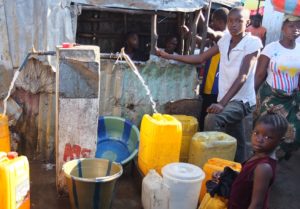10 Facts About Sanitation in Gabon
 Gabon, officially known as the Gabonese Republic, is a coastal country about the size of Colorado, home to 2.1 million people. Independent of French imperial rule for only 60 years, the country maintains strong ties to European and American markets. Gabon neighbors the Atlantic Ocean to its west and many rivers inland, from the Ogooue to the Ivindo. Despite its recent development, however, poverty and access to basic sanitation still plague about one-third of the population. Here are 10 facts about sanitation in Gabon: both the present and plans for the future.
Gabon, officially known as the Gabonese Republic, is a coastal country about the size of Colorado, home to 2.1 million people. Independent of French imperial rule for only 60 years, the country maintains strong ties to European and American markets. Gabon neighbors the Atlantic Ocean to its west and many rivers inland, from the Ogooue to the Ivindo. Despite its recent development, however, poverty and access to basic sanitation still plague about one-third of the population. Here are 10 facts about sanitation in Gabon: both the present and plans for the future.
10 Facts about Sanitation in Gabon
- The country is working toward providing clean water to all. Gabon’s first Libreville Integrated Drinking Water Supply and Sanitation Program aims for universal access to sustainable forms for attaining drinking water and sanitation services by 2025. This program plans to expand the drinking water network out from the capital; by doing so, drinking water will reach about 300,000 more people in surrounding areas. The cities of Akanda, Owendo and Ntoum will all benefit from this infrastructure.
- Every home could soon have its own sanitation equipment. The use of shared sanitation in Gabon, or sanitation services utilized by two or more households, has significantly dropped from 36% of the population in 2003 to 27% in 2017. This is largely due to the increase in infrastructure for these services and outreach programs implemented by the government and international agencies.
- Defecating in public is uncommon, but back on the rise. Open defecation in Gabon is presently low, with 3% of the total population in 2017 compared to other countries like Niger (68%) and Ghana (18%). However, this figure actually shows an alarming increase from 2000, when a mere 1% of the population practiced open defecation.
- Disparities in access to water and sanitation are interconnected. In 2017, from the organized efforts of the WHO and UNICEF, it was reported that 90% of Gabon’s urban areas had access to drinking water but only 49% of households had access to basic sanitation services. In rural areas, availability drops significantly to 55% and 37%, respectively. Such disparities can be attributed to the lack of infrastructure and the wealth gap seen between the two areas.
- Education is helping to improve sanitation. Total Gabon and French organization Sensibilisation, Sante, Sexualite (3S) have been spearheading vital health programs in schools since 2017. These comprehensive programs aim to decrease the infant mortality rate and unsafe abortions. This will be done through education on sexual health, female hygiene and sanitation. As of 2017, over 40,000 people have learned the importance of family planning, contraception and pregnancy management. The program has also trained 42 young peer educators, who will become instrumental in further spreading valuable lessons on sanitation.
- Poor sanitation leaves Gabon’s citizens vulnerable to food and water-borne illnesses. According to a 2020 report from The World Factbook, people in Gabon are at a very high risk of food or waterborne diseases like bacterial diarrhea; however, deaths caused by diarrheal diseases have dropped by 22.8% from 2007 to 2017.
- Industrial pollution contributes to sanitation issues. In many underdeveloped countries, pollutants from excessive chemical use in agriculture and logging severely contaminate waterways. With Gabon’s robust timber industry, this phenomenon is especially apparent. Luckily, though, the country has dedicated one of its three pillars for a better future to environmental sustainability: “Green Gabon,” has diversified the job sector to reduce strain on the timber industry, lessening the amounts of air and water pollution byproducts. This translates into better conservation efforts, drinking water, disease and sanitation in Gabon.
- Drainage systems offer hope for improved sanitation. The Nzeng Ayong Watershed Management Project in Gabon incorporated a water drainage system in urban areas to improve sanitation in Gabon. As part of the National Indicative Program of the European Union, these drainage pipes and sanitation framework provided easy transport of wastewater. This helps prevent water-borne diseases and floods for 30,000 people in Libreville.
- COVID-19 is exacerbating current sanitation problems. Due to the global pandemic, many in Gabon are suffering a hard hit to their economy and the resulting unemployment. Nearly 250,000 additional people are now unable to pay their water bills, severely restricting access to drinking water. Gabon’s Budget Support Programme in Response to the COVID-19 Crisis not only intends to cover bills for those 250,000 people but also to distribute food aid to 60,000 people in its first phase alone.
- International aid organizations are getting involved. The World Bank and UNICEF have provided significant aid to Gabon. The World Bank has contributed $9 million to improve the country’s sanitation by supplying equipment like ambulances, personal protective equipment (PPE) and diagnostic kits. This money will also fund proper medical training and two new COVID-19 diagnostic centers. UNICEF has focused on supporting children in Gabon during COVID-19: the organization has funded sanitation kits, COVID-19 awareness campaigns, HIV/AIDS prevention initiatives and other educational efforts to 950 children without parental care. Mental and psychological resources have also been extended to 6,608 kids. Safe and accessible sexual abuse reporting systems have reached 811 people.
Universal sanitation and related basic needs are clearly part of an intricate web that entangles a host of other internal problems. With the rising influence of existing and emerging domestic and international programs, these investments will improve sanitation; this will ultimately move Gabon toward a healthier future.
– Mizla Shrestha
Photo: Flickr
